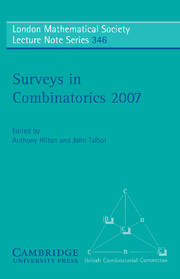Book contents
- Frontmatter
- Contents
- Preface
- 1 Hereditary and monotone properties of combinatorial structures
- 2 Ordering classes of matrices of 0's and 1's
- 3 Cycle decompositions of complete graphs
- 4 Excluding induced subgraphs
- 5 Designs and topology
- 6 The number of points on an algebraic curve over a finite field
- 7 On the efficient approximability of constraint satisfaction problems
- 8 The combinatorics of cryptographic key establishment
- 9 Bandwidth of graphic matroids
6 - The number of points on an algebraic curve over a finite field
Published online by Cambridge University Press: 16 March 2010
- Frontmatter
- Contents
- Preface
- 1 Hereditary and monotone properties of combinatorial structures
- 2 Ordering classes of matrices of 0's and 1's
- 3 Cycle decompositions of complete graphs
- 4 Excluding induced subgraphs
- 5 Designs and topology
- 6 The number of points on an algebraic curve over a finite field
- 7 On the efficient approximability of constraint satisfaction problems
- 8 The combinatorics of cryptographic key establishment
- 9 Bandwidth of graphic matroids
Summary
Abstract
How many points are there on a curve with coordinates in a given finite field when the curve has (a) no singular points or (b) singular points counted once or (c) singular points counted with multiplicity?
What is the maximum number of points on a curve of given genus?
Can curves attaining this maximum number be characterised?
Introduction
Problems in combinatorics, especially in finite geometry, often require a count of the number of solutions of an equation in one or more unknowns defined over a finite field Fq. When two unknowns, say X, Y, occur, the equation is of type f(X, Y) = 0 with f ∈ Fq[X, Y], and the geometric approach for solving it depends on the theory of algebraic curves over finite fields.
Curves over a finite field have applications in the theory of linear error-correcting codes in two areas: (a) the construction of Goppa or algebraic-geometry codes; (b) obtaining bounds for the maximum length of codes when given the dimension and minimum distance.
In cryptography, ciphers are constructed from both elliptic and hyperelliptic curves
It is natural to think about a plane algebraic curve F of equation f(X, Y) = 0 as the set of the points P = (x, y) in the affine plane over the coordinate field K such that f(x, y) = 0. But important numerical results on curves and their intersections, such as Bézout's theorem, have an easier formulation when the following are taken into consideration.
- Type
- Chapter
- Information
- Surveys in Combinatorics 2007 , pp. 175 - 200Publisher: Cambridge University PressPrint publication year: 2007



